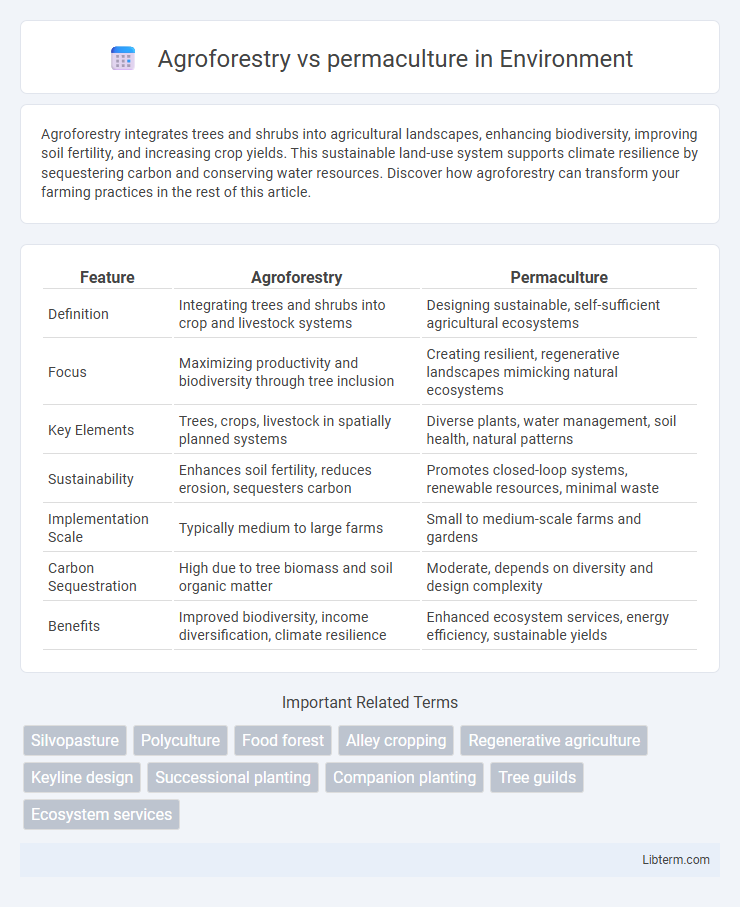Agroforestry integrates trees and shrubs into agricultural landscapes, enhancing biodiversity, improving soil fertility, and increasing crop yields. This sustainable land-use system supports climate resilience by sequestering carbon and conserving water resources. Discover how agroforestry can transform your farming practices in the rest of this article.
Table of Comparison
| Feature | Agroforestry | Permaculture |
|---|---|---|
| Definition | Integrating trees and shrubs into crop and livestock systems | Designing sustainable, self-sufficient agricultural ecosystems |
| Focus | Maximizing productivity and biodiversity through tree inclusion | Creating resilient, regenerative landscapes mimicking natural ecosystems |
| Key Elements | Trees, crops, livestock in spatially planned systems | Diverse plants, water management, soil health, natural patterns |
| Sustainability | Enhances soil fertility, reduces erosion, sequesters carbon | Promotes closed-loop systems, renewable resources, minimal waste |
| Implementation Scale | Typically medium to large farms | Small to medium-scale farms and gardens |
| Carbon Sequestration | High due to tree biomass and soil organic matter | Moderate, depends on diversity and design complexity |
| Benefits | Improved biodiversity, income diversification, climate resilience | Enhanced ecosystem services, energy efficiency, sustainable yields |
Introduction to Agroforestry and Permaculture
Agroforestry integrates trees and shrubs into crop and livestock systems to enhance biodiversity, soil health, and productivity, promoting sustainable land use. Permaculture designs ecosystems modeled on natural processes, combining agriculture, horticulture, and ecological principles to create self-sustaining landscapes. Both approaches prioritize ecological balance, but agroforestry emphasizes tree-crop interactions, while permaculture focuses on holistic system design and resource efficiency.
Core Principles: Agroforestry vs Permaculture
Agroforestry integrates trees and shrubs into agricultural landscapes to enhance biodiversity, improve soil health, and increase crop yields through strategic layering of plants. Permaculture emphasizes designing self-sustaining ecosystems based on natural patterns, prioritizing diversity, energy efficiency, and recycling resources within a closed-loop system. While both approaches promote ecological resilience and sustainable land management, agroforestry focuses on combining woody perennials with crops or livestock, whereas permaculture applies holistic design principles to create multifunctional, regenerative environments.
Historical Background and Origins
Agroforestry traces its origins to ancient agricultural practices in regions like Asia, Africa, and Latin America, where traditional farming integrated trees and shrubs with crops and livestock to enhance productivity and sustainability. Permaculture, developed in the 1970s by Bill Mollison and David Holmgren in Australia, emerged as a holistic design philosophy aimed at creating self-sustaining agricultural ecosystems inspired by natural patterns. Both systems share roots in indigenous knowledge but differ in their formalization, with agroforestry emphasizing practical land-use methods and permaculture focusing on ethical and ecological design principles.
Design Approaches and Methodologies
Agroforestry combines trees and shrubs with crops and livestock in integrated systems to optimize land use through layered planting design, enhancing biodiversity and soil health. Permaculture employs a holistic design methodology based on ecological principles, emphasizing closed-loop systems, energy efficiency, and sustainable resource management to create self-sustaining agricultural ecosystems. Both methodologies prioritize resilience and productivity but differ in scope, with agroforestry focusing on multifunctional land integration and permaculture on comprehensive ethical design frameworks.
Environmental and Ecological Impact
Agroforestry enhances biodiversity by integrating trees and shrubs into agricultural landscapes, improving soil health, reducing erosion, and increasing carbon sequestration. Permaculture creates resilient ecosystems through design principles that mimic natural patterns, promoting water retention, soil fertility, and habitat diversity. Both practices reduce reliance on synthetic inputs, fostering sustainable land use and mitigating climate change impacts.
Biodiversity and Wildlife Benefits
Agroforestry enhances biodiversity by integrating trees with crops and livestock, creating varied habitats that support diverse wildlife populations and improve ecosystem resilience. Permaculture promotes biodiversity through designing self-sustaining agricultural systems that mimic natural ecosystems, fostering native plants, pollinators, and beneficial insects. Both practices increase habitat complexity, boosting wildlife corridors and ecological balance in agricultural landscapes.
Economic Viability and Productivity
Agroforestry integrates trees with crops and livestock to enhance economic viability by diversifying income streams and improving resource use efficiency, often leading to higher long-term productivity and resilience against market fluctuations. Permaculture emphasizes sustainable design principles that maximize productivity through self-sustaining ecosystems, reducing input costs and increasing economic stability over time. Both systems boost productivity but agroforestry tends to offer more immediate economic returns while permaculture focuses on long-term sustainability and resource conservation.
Social and Community Aspects
Agroforestry enhances social cohesion by integrating trees with crops and livestock, promoting shared land stewardship and traditional knowledge exchange among community members. Permaculture fosters community resilience through collaborative design processes, emphasizing local resource use and sustainable living practices that strengthen neighborhood ties. Both systems support social equity by encouraging participatory decision-making and increasing access to diverse, nutritious food sources.
Challenges and Limitations
Agroforestry faces challenges such as complex land management, longer establishment periods, and potential competition between trees and crops for resources. Permaculture encounters limitations in scaling, initial design complexity, and dependency on localized knowledge for effective implementation. Both systems require significant labor input and adaptive management to address site-specific environmental constraints.
Which System Suits Your Land?
Agroforestry integrates trees and shrubs with crops or livestock to enhance biodiversity and soil health, ideal for larger plots with varying topography and a focus on timber or fruit production. Permaculture emphasizes sustainable design principles and diverse plant communities, best suited for small-scale landowners aiming for self-sufficiency and resilient ecosystems. Evaluating your land's size, climate, and primary goals helps determine whether agroforestry's productive layering or permaculture's holistic approach better suits your site.
Agroforestry Infographic

 libterm.com
libterm.com